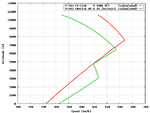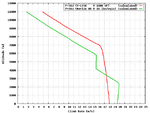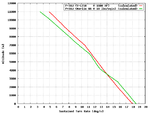Broncazonk
Banned
- 31
- Jun 14, 2008
The P-38K
The Story Of The Best Performing Variant Of The P-38 Lightning - P-38K
The Lockheed P-38K-1-LO is now nearly forgotten. No photographs of the aircraft are known to exist today. Only the original test mule was photographed. It has been relegated to that part of history where one off prototypes and special test aircraft usually go. This is rather unfortunate for this aircraft as it was the benchmark against which all other variants of the P-38 Lightning must be compared. Simply said, it was the best performing Lightning ever to take to the sky.
From the very beginning of America's involvement in World War Two, Lockheed was looking for ways to improve the performance of the P-38. The installation of Rolls Royce XX Merlins was seriously considered. Lockheed went as far as designing the installation package. The advantages of the Merlin engine were numerous. First and foremost was the elimination of the complex turbocharger system. This would also result in a much cleaner engine nacelle. The turbo intercoolers could be removed. That would have allowed for a for more aerodynamic package, closer in shape to that of the original XP-38. Another option was to remove the Prestone radiators and place them under the engine as in the P-40. This location had the additional advantage of reducing the length of the cooling system plumbing. This, in turn, reduced the risk of battle damage to the system. Either option would result in a significant reduction in drag and weight. A further benefit would be gained by the removal of intercooler ducting in the front portion of the outer wings. This volume could be utilized for increased fuel capacity. In fact, that is what was done when the P-38J was designed with revised intercooler cores that eliminated the ducting. This increased internal fuel capacity by 110 gallons.
There were some performance areas that would suffer. While a gain in speed at medium altitudes was expected, the rate of climb would be reduced by as much as 400 feet per minute. Service ceiling would also be reduced as the Packard Merlin XX made considerably less power above 30,000 feet than did the Allison V1710. At the time, no one anticipated the engine and turbocharger problems that developed at high altitude over Europe. Unfortunately, the War Production Board was unwilling to shut down the production line for several months to retool for major design changes required for the engine swap. As a result, the Merlin project was shelved. No P-38 ever flew fitted with Rolls Royce Merlin or Packard engines. The idea of retro-fitting Merlin 61 engines was bantered about 8th Air Force Fighter Command, however there is no evidence that any such conversion ever took place. The prospect of such a modification would have been daunting. This was no simple engine swap, it required large portions of the airframe to be completely redesigned. Stories of Merlin powered Lightnings are, without much doubt, myth.
This, however, did not put an end to seeking greater performance. Lockheed paid close attention to the performance gains achieved with the P-47 when the new "high activity" Hamilton Standard propellers where first fitted on a Republic P-47C in mid 1942 (later, in mid 1943, these propellers were retro-fitted in Britain). The new "paddle" blade prop had significantly increased the rate of climb and acceleration of the "Jug". Lockheed decided that they would install the Hamilton Standard hydraulic propellers on one of the factory test "mules". Thus, was the XP-38K born. The "mule" was an extensively modified P-38E. The original intercoolers were replaced with the newer type introduced on the J model. The initial test results were very encouraging and a P-38G service test airframe (422-81, AFF serial number 42-13558) was selected to be modified.
The new propellers were not the only design changes made in the search for greater performance. This airframe was configured for the Allison V1710F-15 powerplants which were rated at over 1,875 bhp in War Emergency Power (as compared to 1,725 bhp for the V1710F-17 in the P-38L). This was the only P-38 so configured. The potent combination of the engine/propeller promised excellent performance.
There were still other modifications that were necessary. The Hamilton Standard props required a spinner of greater diameter, and the thrust line was slightly higher as well. This in turn, required that new cowlings be manufactured to properly blend the spinners into the engine nacelles. These were hand made and the fit was less than perfect. The new propellers necessitated a change to the reduction gear ratio. The Curtiss Electric props had a normal ratio of 2.00 to 1. The ratio was changed to 2.36 to 1.
Flight tests were conducted from late February through the end of April 1943. Performance was better than hoped for. Maximum speed at critical altitude (29,600 ft) was 432 mph (Military Power). At 40,000 feet, the "K" zipped along at a speed that was 40 mph faster than the current production P-38J could attain at this same height. Maximum speed in War Emergency Power, at critical altitude, was expected to exceed 450 mph. The increase in ceiling was just as remarkable. Flown to 45,000 ft on an extremely hot and humid day, Lockheed engineers predicted a "standard day" service ceiling in excess of 48,000 ft! Improvement of the cowling fit and the elimination of the heavy coat of paint would have gained even more performance. Due to the added efficiency of the new propellers, range was expected to increase by 10 to 15 %. Lockheed appeared to have a world-beater on their hands.
The plane, now designated the P-38K-1-LO was flown to Elgin Field for evaluation by the USAAF. Flown against the P-51B and the P-47D, this Lightning proved to be vastly superior to both in every category of measured performance. What astounded the evaluation team was the incredible rate of climb demonstrated by the P-38K. From a standing start on the runway, the aircraft could take off and climb to 20,000 feet in 5 minutes flat! The "K", fully loaded, had an initial rate of climb of 4,800 fpm in Military Power. In War Emergency Power, over 5,000 fpm was predicted.
In light of this incredible level of performance, you would certainly expect that the Government would be falling all over themselves to quickly get the P-38K into production. Yet, this was not the case. The War Production Board was unwilling to allow a short production suspension in order to get new tooling on line for the required change to the engine cowling. Even when Lockheed promised that the stoppage would only be for 2 or 3 weeks, their request was turned down.
The true consequences of this pig-headed thinking will never be known. What would have been the impact of such a high performance fighter arriving in force to the forward combat areas in mid 1943? How many lost fighter pilots would have survived thanks to the awe inspiring performance of the P-38K? Again, we can never know these things. What we do know, is that due to bureaucratic myopia, neither the P-38K nor a Merlin powered Lightning ever really had a chance to make an impact upon the air war. For all those pilots who died at the controls of lesser aircraft, the War Production Board bears a measure of responsibility for their fate.
The Story Of The Best Performing Variant Of The P-38 Lightning - P-38K
The Lockheed P-38K-1-LO is now nearly forgotten. No photographs of the aircraft are known to exist today. Only the original test mule was photographed. It has been relegated to that part of history where one off prototypes and special test aircraft usually go. This is rather unfortunate for this aircraft as it was the benchmark against which all other variants of the P-38 Lightning must be compared. Simply said, it was the best performing Lightning ever to take to the sky.
From the very beginning of America's involvement in World War Two, Lockheed was looking for ways to improve the performance of the P-38. The installation of Rolls Royce XX Merlins was seriously considered. Lockheed went as far as designing the installation package. The advantages of the Merlin engine were numerous. First and foremost was the elimination of the complex turbocharger system. This would also result in a much cleaner engine nacelle. The turbo intercoolers could be removed. That would have allowed for a for more aerodynamic package, closer in shape to that of the original XP-38. Another option was to remove the Prestone radiators and place them under the engine as in the P-40. This location had the additional advantage of reducing the length of the cooling system plumbing. This, in turn, reduced the risk of battle damage to the system. Either option would result in a significant reduction in drag and weight. A further benefit would be gained by the removal of intercooler ducting in the front portion of the outer wings. This volume could be utilized for increased fuel capacity. In fact, that is what was done when the P-38J was designed with revised intercooler cores that eliminated the ducting. This increased internal fuel capacity by 110 gallons.
There were some performance areas that would suffer. While a gain in speed at medium altitudes was expected, the rate of climb would be reduced by as much as 400 feet per minute. Service ceiling would also be reduced as the Packard Merlin XX made considerably less power above 30,000 feet than did the Allison V1710. At the time, no one anticipated the engine and turbocharger problems that developed at high altitude over Europe. Unfortunately, the War Production Board was unwilling to shut down the production line for several months to retool for major design changes required for the engine swap. As a result, the Merlin project was shelved. No P-38 ever flew fitted with Rolls Royce Merlin or Packard engines. The idea of retro-fitting Merlin 61 engines was bantered about 8th Air Force Fighter Command, however there is no evidence that any such conversion ever took place. The prospect of such a modification would have been daunting. This was no simple engine swap, it required large portions of the airframe to be completely redesigned. Stories of Merlin powered Lightnings are, without much doubt, myth.
This, however, did not put an end to seeking greater performance. Lockheed paid close attention to the performance gains achieved with the P-47 when the new "high activity" Hamilton Standard propellers where first fitted on a Republic P-47C in mid 1942 (later, in mid 1943, these propellers were retro-fitted in Britain). The new "paddle" blade prop had significantly increased the rate of climb and acceleration of the "Jug". Lockheed decided that they would install the Hamilton Standard hydraulic propellers on one of the factory test "mules". Thus, was the XP-38K born. The "mule" was an extensively modified P-38E. The original intercoolers were replaced with the newer type introduced on the J model. The initial test results were very encouraging and a P-38G service test airframe (422-81, AFF serial number 42-13558) was selected to be modified.
The new propellers were not the only design changes made in the search for greater performance. This airframe was configured for the Allison V1710F-15 powerplants which were rated at over 1,875 bhp in War Emergency Power (as compared to 1,725 bhp for the V1710F-17 in the P-38L). This was the only P-38 so configured. The potent combination of the engine/propeller promised excellent performance.
There were still other modifications that were necessary. The Hamilton Standard props required a spinner of greater diameter, and the thrust line was slightly higher as well. This in turn, required that new cowlings be manufactured to properly blend the spinners into the engine nacelles. These were hand made and the fit was less than perfect. The new propellers necessitated a change to the reduction gear ratio. The Curtiss Electric props had a normal ratio of 2.00 to 1. The ratio was changed to 2.36 to 1.
Flight tests were conducted from late February through the end of April 1943. Performance was better than hoped for. Maximum speed at critical altitude (29,600 ft) was 432 mph (Military Power). At 40,000 feet, the "K" zipped along at a speed that was 40 mph faster than the current production P-38J could attain at this same height. Maximum speed in War Emergency Power, at critical altitude, was expected to exceed 450 mph. The increase in ceiling was just as remarkable. Flown to 45,000 ft on an extremely hot and humid day, Lockheed engineers predicted a "standard day" service ceiling in excess of 48,000 ft! Improvement of the cowling fit and the elimination of the heavy coat of paint would have gained even more performance. Due to the added efficiency of the new propellers, range was expected to increase by 10 to 15 %. Lockheed appeared to have a world-beater on their hands.
The plane, now designated the P-38K-1-LO was flown to Elgin Field for evaluation by the USAAF. Flown against the P-51B and the P-47D, this Lightning proved to be vastly superior to both in every category of measured performance. What astounded the evaluation team was the incredible rate of climb demonstrated by the P-38K. From a standing start on the runway, the aircraft could take off and climb to 20,000 feet in 5 minutes flat! The "K", fully loaded, had an initial rate of climb of 4,800 fpm in Military Power. In War Emergency Power, over 5,000 fpm was predicted.
In light of this incredible level of performance, you would certainly expect that the Government would be falling all over themselves to quickly get the P-38K into production. Yet, this was not the case. The War Production Board was unwilling to allow a short production suspension in order to get new tooling on line for the required change to the engine cowling. Even when Lockheed promised that the stoppage would only be for 2 or 3 weeks, their request was turned down.
The true consequences of this pig-headed thinking will never be known. What would have been the impact of such a high performance fighter arriving in force to the forward combat areas in mid 1943? How many lost fighter pilots would have survived thanks to the awe inspiring performance of the P-38K? Again, we can never know these things. What we do know, is that due to bureaucratic myopia, neither the P-38K nor a Merlin powered Lightning ever really had a chance to make an impact upon the air war. For all those pilots who died at the controls of lesser aircraft, the War Production Board bears a measure of responsibility for their fate.



